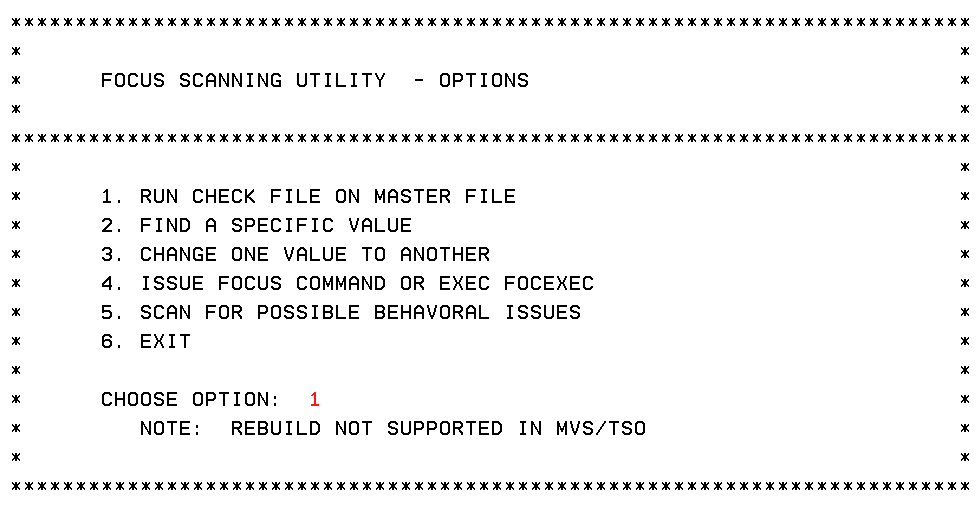Procedure: How to Review Master Files
- To validate that existing Master Files
will be accepted in a new release, start a FOCUS session for the
new release and select Option 1 (the default), as shown in the following
image.

- Press Enter.
The FOCUS Scanning Utility - Target Files screen opens, as shown in the following image.

- Enter search criteria for the members to be scanned.
- Enter the Logical Record Length (LRECL) of the PDS
to be scanned. The default value is 80.
Currently, an LRECL of 80 and 160 are supported. If the value is different, contact Information Builders Customer Support Services for a Master File to use to read the scanned file.
- Enter the fully-qualified name of the PDS to be scanned.
If your allocations concatenate multiple PDSs, you must search these one at a time.
- Enter search criteria for the members to be scanned. The string
will automatically be placed within quotation marks, so you do not
need to type the quotation marks as part of the search string. Note
that initial spaces that are entered in the search string are captured.
The search string can consist of one of the following:
- A single member name.
- An asterisk (*), to scan all members.
- A mask containing the wildcard characters $ and $*. The dollar
sign indicates that any character in that position is acceptable.
The $* is shorthand for writing a sequence of dollar signs to fill
the end of the mask without specifying a length. This combination
can only be used at the end of the mask. For example, the mask B$* scans
all members whose name begins with the letter B. The search is case insensitive.
The following sample screen searches the PDS USER1.MASTER.DATA for
all member names that start with the letter L:

- Enter the Logical Record Length (LRECL) of the PDS
to be scanned. The default value is 80.
- Press Enter.
The utility issues the CHECK FILE command for all member names that satisfy the search criteria. It lists each member scanned and either:
- Issues an OK message for the member.
- Lists the FOCUS messages that identify the problems.
When the utility has finished issuing the CHECK FILE command for all of the selected members, it issues a FINISHED message and exits the utility.
For example:
(FOC488) THE DATASET IS IN THE CATALOG: 'USER1.MASTER.DATA' PERFORMING OPERATION ON LINEF LINEF CHECKS OK PERFORMING OPERATION ON LOXSUMO LOXSUMO CHECKS OK PERFORMING OPERATION ON LSL111M (FOC03601) ERROR AT OR NEAR LINE 1 IN LSL111M (FOC1822) WARNING. INVALID SYMBOL: >10< vv 10 (FOC03601) ERROR AT OR NEAR LINE 2 IN LSL111M (FOC1822) WARNING. INVALID SYMBOL: >10< vv 10 (FOC03601) ERROR AT OR NEAR LINE 3 IN LSL111M (FOC1822) WARNING. INVALID SYMBOL: >10< vv 10* (FOC03601) ERROR AT OR NEAR LINE 4 IN LSL111M (FOC1822) WARNING. INVALID SYMBOL: >10< vv 10 (FOC03601) ERROR AT OR NEAR LINE 5 IN LSL111M (FOC1822) WARNING. INVALID SYMBOL: >10< vv 10* PERFORMING OPERATION ON L128 (FOC259) FIELDNAME EXCEEDS ITS MAXIMUM SIZE: MODEL1234567890123456789012345678901234567890123456789012345678901234567 vvvvvvvvvvvvvvvvvvvvvvvvvvvvvvvvvvvvvvvvvvvvvvvvvvvvvvvvvvvvvvvvvvvvvvvv MODEL1234567890123456789012345678901234567890123456789012345678901234567, FINISHED. THANK YOU.
Note: The v characters below a line indicate where issues exist on the line.
You can now examine the members that generated FOCUS messages and make the required adjustments. Typically, with newer releases, there may be code tightening, which may cause issues in cases where no issue occurred previously. Repair the issue and rerun the CHECK FILE operation to validate that it will now pass the parsing test.